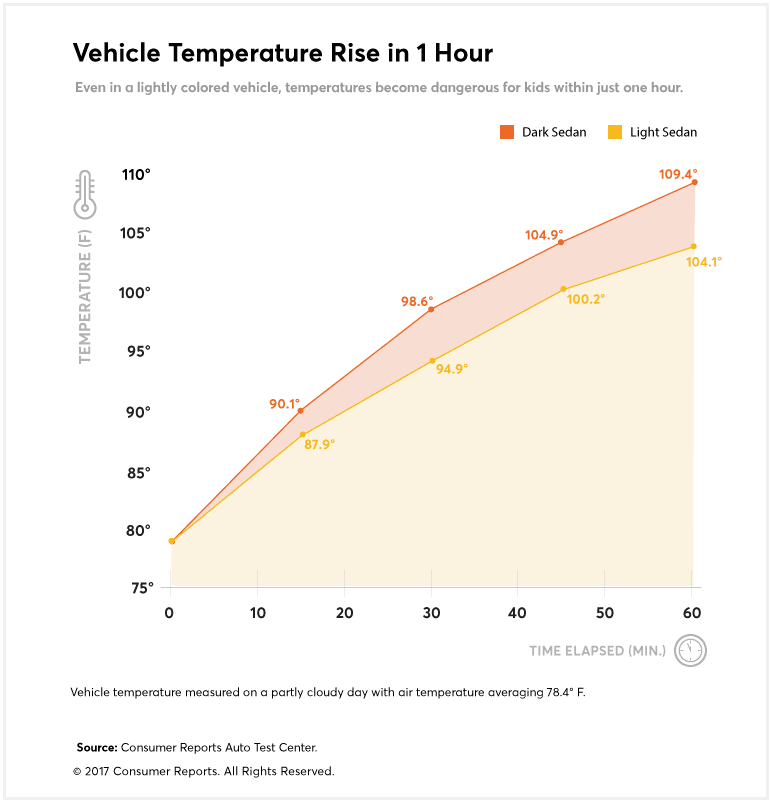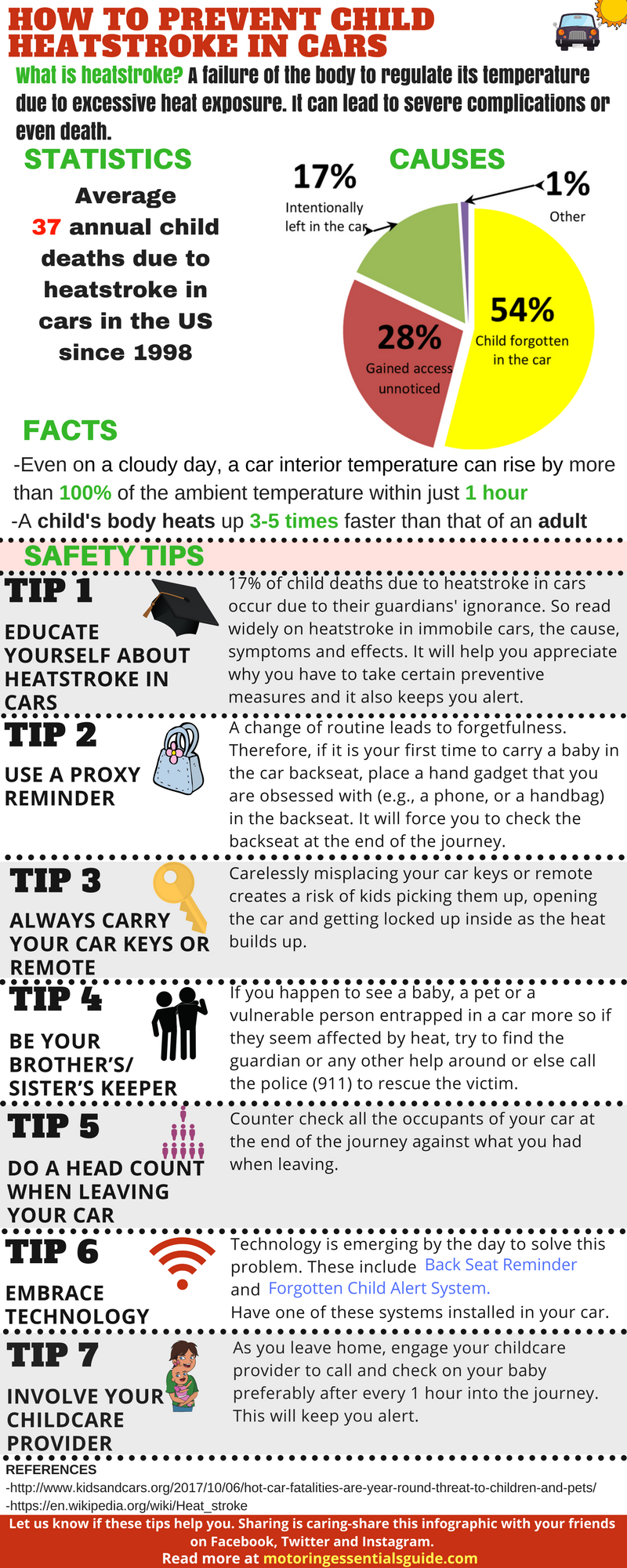
As a family man or woman, one of the best conveniences is having a car.
You can be able to drop your children at their school before heading to work, take the family out on weekends, and the car also comes to your rescue during some emergencies at home.
But did you know that your car could subject your child to a heatstroke if you forget him or her there? Or you forget to lock your car?
By now I know you are wondering how on earth you could forget your child in the car.
But here is the fact:
More than half of the recent child deaths due to heatstroke in cars occurred because the baby’s guardian forgot him or her in the car.
Only 18% occurred because the guardian intentionally left his child in the car oblivious to the fact it could get too hot to bear. About 30% of such deaths occurred because the child climbed into the car unnoticed, perhaps to play and got trapped in as the car interior heated up.
What’s the verdict?
Since the likelihood of you forgetting your baby in the car is real, let’s discuss prevention because it makes more sense than levying accusations of forgetfulness.
But before we dive into heatstroke prevention:
What is heatstroke?
According to
Mayo Clinic, “Heatstroke is a condition caused by your body overheating, usually as a result of prolonged exposure to or physical exertion in high temperatures.” In this case, the body temperature exceeds 104 °F (40 °C) and you are more likely to expect it in the summer months.
Besides the high body temperature, other symptoms include a severe headache, confused mental state, a red hot and dry skin, nausea and vomiting, rapid and shallow breathing.
If the heatstroke is left untreated or treatment is delayed, it may lead to severe complications such as heart or kidney failure, damage to the brain and muscles and even death.
What causes heatstroke?
Let’s start with a fact:
Don’t get cheated that the weather is not hot enough to cause heatstroke. On a day when the outside temperature is 61 °F (16 °C), the temperature of an immobile car with closed windows can rise to more than 105 °F (40.56 °C) within just 1 hour.
In fact, researchers have proven that the risk of your child getting heatstroke if left in the car is real anytime, all year round. On a day when the outside temperature is 60 °F (typical autumn weather) the car interior temperature can rise to 110 °F in a couple of hours. And this comfortably exceeds the heatstroke threshold of 104 °F.
And here is another fact:
Your child is more susceptible to heat extremes than you because he or she can’t regulate his/her body temperature efficiently. This is because his/her body heats up 3 to 5 times faster than that of an adult, and this makes him/her dehydrate faster.
What are the statistics?
In the US, an average of 37 children has died from heatstroke in a car since the year 1998. It is the leading cause of child car deaths, in the league of car crashes.
Actionable tips that you can use to prevent child heatstroke in your car
1. Educate yourself on the existence and dangers of heatstroke in cars
You earlier learned that 18% of child deaths due to heatstroke in cars occur due to their guardians’ ignorance. So read widely on heatstroke in immobile cars, the cause, symptoms and effects.
It will help you to appreciate why you have to take certain measures to prevent heatstroke in your car and it also keeps you alert.
2. Use a proxy reminder
They say old habits die hard. For instance, you can never leave the house, your car, or a meeting without your smart phone, wallet, or purse.
And in a similar manner, new habits are equally hard to learn. For instance, if you carry your baby in a rear facing car seat for the first time, you are more likely to forget that there is someone in the backseat at the end of your journey.
So how do you make things work here?
Combine the two. Place your phone, wallet or handbag in the backseat when departing and when getting out of the car, you will be forced to go to the back seat to fetch your proxy reminder only to realize that your child or pet is there.
Another tactic would be to get used to carrying a toy or a stuffed animal in the backseat and moving it to the front seat whenever you carry a child in the back seat. When leaving the car you are more likely to automatically remember to take the dolly to the backseat, only to find your baby there.
3. Always carry your car keys or remote
Kids are nowadays learning how to operate gadgets faster than they learn how to do their schoolwork unassisted.
Therefore, carelessly misplacing your car keys or remote is courting imminent danger. Your kid or any other kid around can pick up them up, open the car and get locked up inside as the heat builds up.
The problem with small kids is that they cannot be able to ask for help or raise the alarm when they get hot and dehydrated, the same thing with the elderly and pets.
4. Be your brother’s/ sister’s keeper
If you happen to see a baby, a pet or a vulnerable person entrapped in a car more so if they seem affected by heat, try to find the guardian or any other help around or else call the police (911) to rescue the victim.
5. Do a head count when leaving your car
Make a habit of counterchecking all the occupants of your car at the end of the journey with what you had when leaving.
Learning habits such as using the car keys instead of the remote starter and placing one of your hand gadgets in the backseat will force you to give your car that one last inspection before leaving.
6. Involve your childcare provider
You will agree with me that teamwork is better than individual effort and it really applies in this situation.
As you leave home, engage your childcare provider to call and check on your baby preferably after every 1 hour into the journey. This will keep you alert.
7. Embrace technology
Technology has helped solve several life challenges, no less the issue of forgetting your baby, a vulnerable guardian or a pet in the car.
Let us look at some of the emerging technologies for this problem (#2 is our favorite);
Cabin cooling technology
Some vehicle manufacturers such as Tesla have started integrating technology meant to prevent child heatstroke. Tesla’s Cabin Overheat Protection system automatically starts lowering the car interior temperature when it gets too hot (that is, exceed 105 °F). However, the system currently has a number of disadvantages;
- It is only available in Tesla cars models S and X, obviously premium priced cars.
- The 105 °F at which the system turns on is a degree above the human heatstroke threshold and therefore it might be way too hot to keep your child or pet cool.
- The system stops operating when the battery charge hits 20% or less.
- It might need you to invest in a new car
Forgotten child alert system
Instead of purchasing a car with a cabin cooling system which we have seen may fail to serve the purpose of preventing heatstroke, invest in one of the many proprietary alert systems.
In 2015, a San Jose inventor developed a forgotten child alert system called iRemind.
According to the creator Marti McCurdy, a sensor is installed underneath the car seat and it senses whether there is a baby in the car seat or not.
So when you leave your baby in the car and walk away for long, it sends an irritating alarm to your smartphone or key fob and it stops only after you have taken your baby out of the car.
It can also sense when a user adjustable car interior temperature is exceeded and trigger an alarm.
What we love about it is that it fast to respond and its battery can last for two years.
A similar system and equally excellent system is the Back Seat Reminder system.
Conclusion
Both the risk of you forgetting your baby in your car and the risk of him getting heat stroke left in a car is real, and it’s wise for you to learn and practice the above preventive measures.
The overall aim of these measures is to help you act proactively and not to wish you did.
How to Prevent Child Heat Stroke in Cars Cheat Sheet [Infographic]
Share this infographic with your readers by embedding this code:
[code]<a href=”http://motoringessentialsguide.com/child-left-in-car-how-to-prevent-child-heatstroke-in-cars/”><img class=”aligncenter size-full wp-image-678″ src=”http://motoringessentialsguide.com/wp-content/uploads/2017/12/How-to-prevent-child-heatstroke-in-cars-infographic.png” alt=”An infographic about how to prevent child heatstroke in cars” width=”800″ height=”2000″ /></a>[/code]
Related Sources:
https://www.mayoclinic.org/diseases-conditions/heat-stroke/symptoms-causes/syc-20353581
http://www.kidsandcars.org/2017/10/06/hot-car-fatalities-are-year-round-threat-to-children-and-pets/


Thanks for the awesome post. It is quite amazing that a car’s interior temperature rises that fast even in ambient temperature and that a child’s body temperature rises up to 5 times compared to an adult. Luckily there are tons of ideas to prevent such an accident but some of them such as calling authorities and child care providers may be a challenge when one is in a foreign country.
For your expat tax returns (annual income tax returns with Internal Revenue Service and FBAR with FinCEN) and any other US expat tax consultancy, contact us at Bright!Tax (https://brighttax.com/).